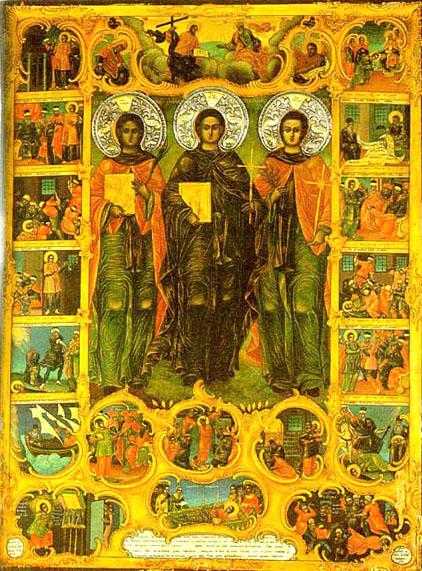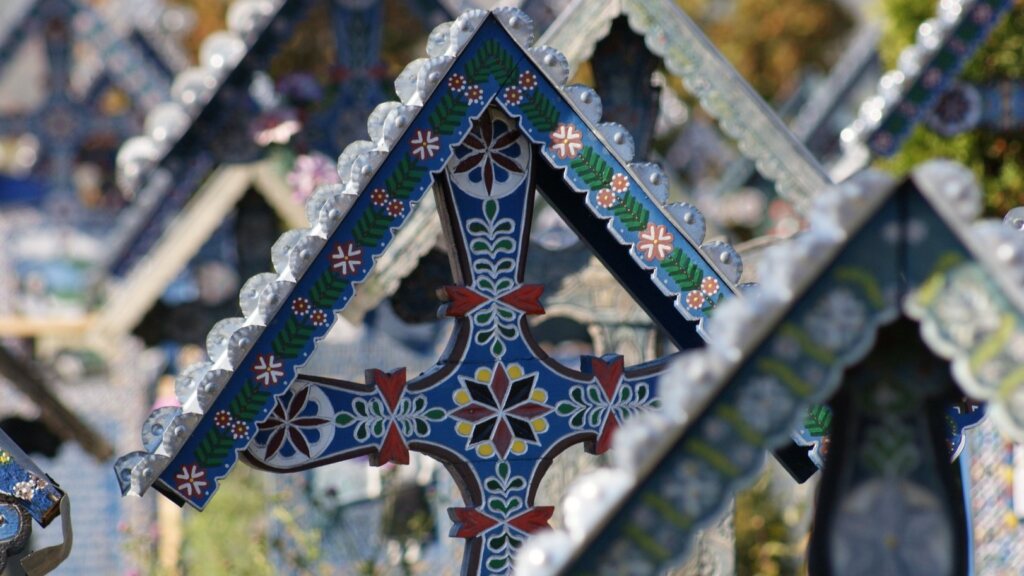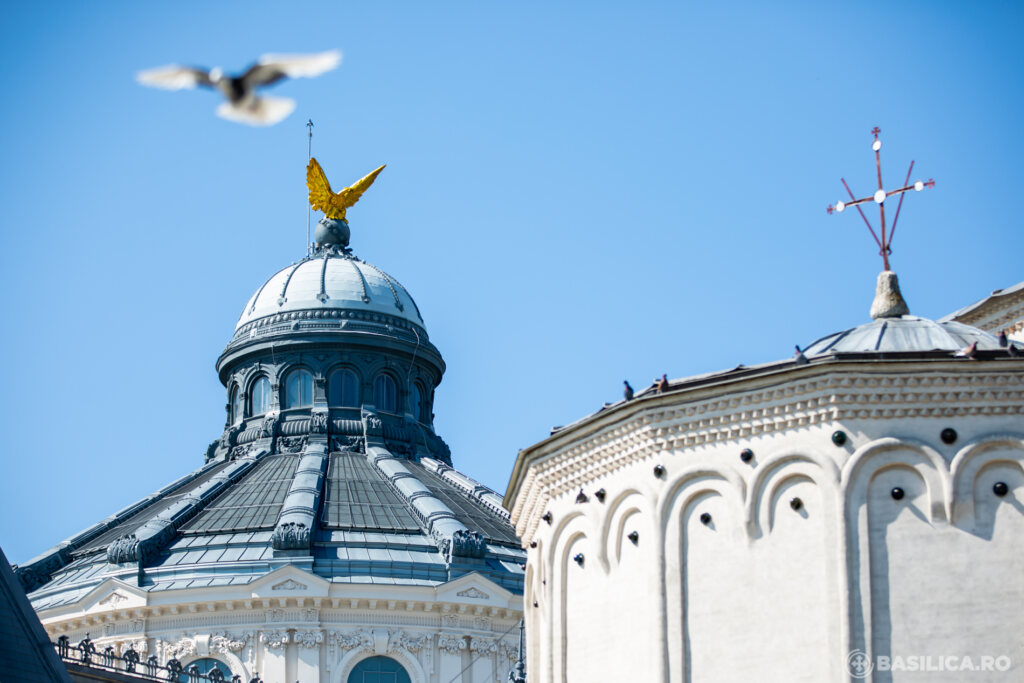Prophet Jeremiah
One of the four great Old Testament prophets, he was son of the priest Helkiah from the city of Anathoth near Jerusalem, and he lived 600 years before the Birth of Christ, under the Israelite king Josiah and four of his successors.
He was called to prophetic service at the age of fifteen, when the Lord revealed to him that even before his birth the Lord had chosen him to be a prophet. Jeremiah refused, citing his youth and lack of skill at speaking, but the Lord promised to be always with him and to watch over him.
He touched the mouth of the chosen one and said, “Behold, I have put My words into your mouth. Behold, I have appointed you this day over nations and kingdoms, to root out and to pull down, to destroy and to rebuild, and to plant” (Jer. 1:9-10).
From that time Jeremiah prophesied for twenty-three years, denouncing the Jews for abandoning the true God and worshipping idols, predicting sorrows and devastating wars. He stood by the gates of the city, and at the entrance to the Temple, everywhere where the people gathered, and he exhorted them with imprecations and often with tears. The people, however, mocked and abused him, and they even tried to kill him.
Depicting for the Jews their impending enslavement to the king of Babylon, Jeremiah first placed on his own neck a wooden, and then an iron yoke, and thus he went about among the people. Enraged at the dire predictions of the prophet, the Jewish elders
threw the Prophet Jeremiah into a pit filled with horrid, slimy creatures, where he almost died. Through the intercession of the God-fearing royal official Habdemelek, the prophet was pulled out of the pit, but he did not cease his prophecies, and for this he was carted off to prison. Under the Jewish king Zedekiah his prophecy was fulfilled.
Nebuchadnezzar came, slaughtered many people, carried off a remnant into captivity, and Jerusalem was pillaged and destroyed. Nebuchadnezzar released the prophet from prison and permitted him to live where he wanted. The prophet remained at the ruins of Jerusalem and bewailed his nation’s misfortune.
According to Tradition, the Prophet Jeremiah took the Ark of the Covenant with the Tablets of the Law and hid it in one of the caves of Mount Nabath (Nebo), so that the Jews could no longer find it (2 Mac. 2). Afterwards, a new Ark of the Covenant was fashioned, but it lacked the glory of the first.
Among the Jews remaining in their fatherland there soon arose internecine clashes: Hodoliah, Nebuchadnezzar’s viceroy, was murdered. The Jews, fearing the wrath of Babylon, decided to flee into Egypt. The Prophet Jeremiah disagreed with their intention, predicting that the punishment which they feared would befall them in Egypt.
The Jews would not listen to the prophet, however, and taking him along by force, they went into Egypt and settled in the city of Tathnis. There the prophet lived for four years and was respected by the Egyptians, because by his prayers he killed crocodiles and other creatures infesting these parts.
When Jeremiah prophesied that the King of Babylon would invade Egypt and annihilate the Jews living there, the Jews murdered him. In that very same year the saint’s prophecy was fulfilled. There is a tradition that 250 years later, Alexander the Great transported the relics of the holy Prophet Jeremiah to Alexandria.
The Prophet Jeremiah wrote his Book of Prophecies and also the Book of Lamentations about the desolation of Jerusalem and the Exile. The times in which he lived and prophesied are described in 4/2 Kings (Ch. 23-25) and in the Second Book of Chronicles (36:12) and in 2 Maccabbees (Ch. 2).
In the Gospel of Matthew it is said that the betrayal of Judas was foretold by the Prophet Jeremiah, “And they took thirty pieces of silver, the price of him on whom the sons of Israel had set a price, and they gave them for the potter’s field, as the Lord directed me” (Mt. 27:9-10). Perhaps Jeremiah 32:6-15 is meant.
Even after his death, the Prophet Jeremiah was regarded as a wonderworker. Dust from his tomb was believed to cure snake-bite, and many Christians pray to him for this purpose.
Troparion — Tone 2
Celebrating the memory / of Your Prophet Jeremiah, O Lord, / for his sake, we entreat You to save our souls.
Martyrs Ignatius, Acacius and Euthymius

Martyr Euthymius
This holy New Martyr of Christ was born in Demitsana in the Peloponnesos. His parents were Panagiotes and Maria, and he was given the name Eleutherius in Baptism. Eleutherius was the youngest of five children (the others were George, Christos, John, and Katerina).
After attending school in Demetsana, Eleutherius and John traveled to Constantinople to enroll in the Patriarchal Academy. Later, they went to Jassy, Romania where their father and brothers were in business. Some time afterwards, Eleutherius decided to go to Mt. Athos to become a monk. Because of a war between Russia and Turkey, he was able to travel only as far as Bucharest. There he stayed with the French consul, then with an employee of the Russian consul.
Eleutherius began to pursue a life of pleasure, putting aside his thoughts of monasticism. When hostilities ceased, Eleutherius made his way to Constantinople in the company of some Moslems. On the way, he turned from Orthodoxy and embraced Islam.
Soon his conscience began to torment him for his denial of Christ. The other Moslems began to notice a change in his attitude, so they restricted his movements and kept a close watch on him.
Eleutherius, however, prayed that God would permit him to escape.
With some assistance from the Russian embassy, Eleutherius boarded a ship and sailed to Mt. Athos. At the Great Lavra Eleutherius was chrismated and received back into the Orthodox Church, and also became a monk with the name Euthymius.
Euthymius read the New Martyrologion of Saint Νikόdēmos (July 14), and was inspired by the example of the New Martyrs. He then became consumed with a desire to wipe out his apostasy with the blood of martyrdom.
Saint Euthymius went to Constantinople with a monk named Gregory, arriving on March 19, 1814. A few days later, on Palm Sunday, he received Holy Communion. Removing his monastic garb, he dressed himself as a Moslem and went to the palace of the Grand Vizier, Rusud Pasha. Saint Euthymius, holding palms in his hand, confessed that he was an Orthodox Christian, and wished to die for Christ.
Saint Euthymius was killed about noon on March 22, 1814 in Constantinople, thereby earning a place in the heavenly Kingdom. The head of Saint Euthymius is in the Monastery of Saint Panteleimon on Mt. Athos.
Martyr Ignatius
The holy New Martyr Ignatius was born in the village of Eski Zagora in the Trnovo region of Bulgaria, and was named John in Baptism. While he was still a young child, his parents George and Maria moved to the city of Philippopolis and enrolled him in a school there.
Although he did well at school, he had a strong desire for the monastic life. Upon reaching adulthood, he entered the Rila monastery in western Bulgaria. There he was assigned to an Elder, with whom he lived in obedience for six years. When the Elder’s strictness became unbearable, John returned home.
About that time the Serbs rose in revolt against the Moslem government. John’s father was asked to take command of an Ottoman brigade, but he refused to fight against other Orthodox Christians.
The Moslems attacked George with furious anger. He was stabbed and then beheaded. John’s mother and sisters were also taken by the Hagarenes, and they ultimately agreed to convert to Islam.
John fled and hid in the home of an elderly Orthodox woman. His mother and sisters learned where he was hiding, and they told the Moslems. Those sent to capture him did not know what he looked like, so the old woman told them she did not know him. The woman helped him escape to Bucharest, Romania, where he became acquainted with Saint Euthymius, who would also endure martyrdom.
John did not wish to stay in Bucharest, however, and so he left for Mt. Athos. On the way he visited the village of Soumla, where he ran into his friend Father Euthymius again. Learning that Euthymius had denied Christ and become a Moslem, John became very sad and left the village.
He had not gotten very far when Turkish soldiers stopped him and took all his possessions. They demanded that he convert to Islam, and in his fright he told them that he would do so. Satisfied with this reply, they let him go.
John reached the village of Eski Zagora, where he met an Athonite monk from the monastery of Grigoriou. They journeyed to the Holy Mountain together, and John settled in the Skete of Saint Anna.
In time, John was found worthy of monastic tonsure, and was given the new name Ignatius. The Elder Acacius blessed him to travel to Constantinople with the monk Gregory in order to bear witness to Christ. After receiving the Holy Mysteries in Constantinople, Ignatius felt he was ready for his ordeal.
Dressed in Moslem garb, Ignatius went before the kadi and proclaimed his faith in Christ.
The holy New Martyr Acacius was born at Neochorion, Macedonia near Thessalonica in the eighteenth century. The oldest son of Bulgarian peasants, he was named Athanasius at his baptism. When he was nine years old, his family moved to the city of Serres. Athanasius was apprenticed to a cobbler, who frequently beat him. On the night of Holy Friday, after a particularly severe beating, he wandered onto the street and two Moslem women comforted him, brought him home and fed him. Pretending sympathy, they urged him to deny Christ.
They took the boy to Yusuf Bey, who adopted him, gave him a Moslem name, and had him circumcised. He lived in that home for nine years.
At first, the wife of Yusuf Bey treated Athanasius with maternal love, but this later turned into a lustful passion. Just as the righteous Joseph (March 31) rejected the advances of Potiphar’s wife (Genesis 39:8-10), so did Athanasius spurn the advances of the Moslem woman. So she told her husband that Athanasius had tried to force himself on her. His Turkish father threw him out of the house, and the young man returned to Thessalonica to find his real parents. His mother told him it was too dangerous for him to stay with them, and so he went to Mt Athos.
At first he lived at the Hilandar Monastery for a while, but he spent time in other monasteries as well. He confessed his apostasy to Father Nicholas at the Xenophontos Monastery, who read the prescribed prayers and received him back into the Church through Chrismation. Athanasius returned to Hilandar for about a year, then went to Ivḗron.
While at the skete at Ivḗron he heard of Saints Euthymius and Ignatius, and desired to imitate their feat of martyrdom.
he left for Constantinople with the Elder Gregory, who had also accompanied Saints Ignatius and Euthymius on their way to martyrdom. They left Mt Athos on a ship, arriving in Constantinople thirteen days later. On April 22, Saint Acacius received Holy Communion at a church in Galata, then returned to the ship. He changed into Moslem clothing and went with Father Gregory to the Porte, where a doorkeeper asked them what they wanted.
Saint Acacius related his story, saying that he had been deceived into renouncing Christianity and accepting Islam, but now he had come to his senses. Denouncing Mohammed as a false prophet, he loudly proclaimed that he was a Christian.
Saint Acacius gave his life for Christ on May 1, 1816 at six o’clock in the evening. Some pious Christians ransomed the saint’s body from the Turks, and Father Gregory brought it back to Mt Athos. The holy relics were brought to Ivḗron and buried in a church dedicated to Saints Ignatius and Euthymius.
Although some sources give the year of the saint’s martyrdom as 1815, there is a letter from Saint Acacius to a certain spiritual Father on Mt Athos dated April 27, 1816 which states that he is on his way to martyrdom. Thus, the year is 1816.
The heads of Saints Acacius, Euthymius, and Ignatius are in the Russian monastery of Saint Panteleimon on the Holy Mountain.
Tr by oca.org






